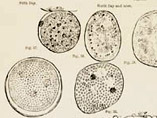 About the collection
About the collection
Disease: Malaria
An overview of information in the Medical History of British India collection about malaria, its treatment, and the discovery about mosquitoes.
Fevers had been considered one of the leading causes of death in India from the early 19th century. The presence of weeds, stagnant water, filthy pools were believed to generate 'malaria' or 'miasma', 'elements of decomposition or the proportions of water and dead vegetable matter, and a certain degree of temperature' which created the conditions in which fevers attacked the human constitution.
Canal irrigation
The Indian countryside, especially the lowlands in eastern India and forested areas elsewhere came to be associated with endemic malarial fever. Although the clearing of jungles was expected to reduce the danger from fever in such areas, colonial projects such as canal systems for irrigation, railway lines and roads on raised embankments created new regions where endemic malaria prevailed. As these projects were designed without taking into account natural drainage flows, they created artificial pools which provided new sites for the breeding of anopheline mosquitoes.
In the 1840s, a committee was appointed to examine the possible connection between canal irrigation and the incidence of malaria. Strategies advanced for malaria prevention during late 19th-century British India focused on the drainage or avoidance of swampy areas, and the use of prophylaxis provided by various cinchona preparations, most commonly quinine.
Malaria and mosquitoes
The discoveries by Laveran and Ronald Ross in the late 19th century revealed that mosquito bites by anopheles mosquitoes carrying protozoan parasites called 'plasmodia' were the cause of malaria, opening up new avenues of laboratorial research in the problems of malaria prevention. In 1900, R S Christophers, J W W Stephens and S P James conducted experiments in mosquito eradication at the military cantonment of Mian Mir in the Punjab. All-India conferences to disseminate knowledge on the transmission of malaria and discuss strategies of malaria prevention were organised in 1900 and 1909.
Punjab Malaria Surveys
The following years saw an increase in research regarding malaria prevention in different regions. Punjab emerged as an important regional focus for malaria research due to the high endemicity and recurrent epidemics of malaria in the region. The Punjab Malaria Surveys (1909-1911), conducted under Christophers, and subsequent regional surveys in other parts of India focused on providing preventive solutions that focused on quinine, rather than on removing structural problems such as ineffective drainage. The expense involved in the latter strategy was much greater than quinine prophylaxis.
Although criticised by other medical officers and a committee appointed by the League of Nations, malaria prevention continued to focus on quinine until the malaria eradication campaigns using DDT were launched by the World Health Organisation.



